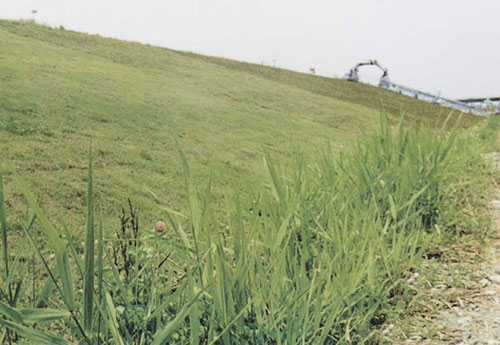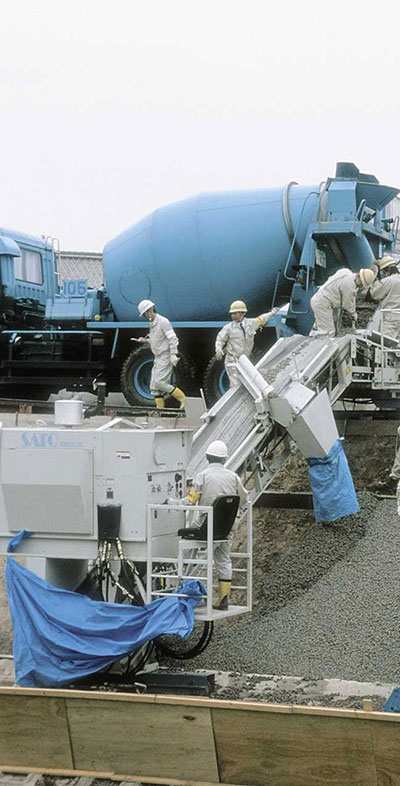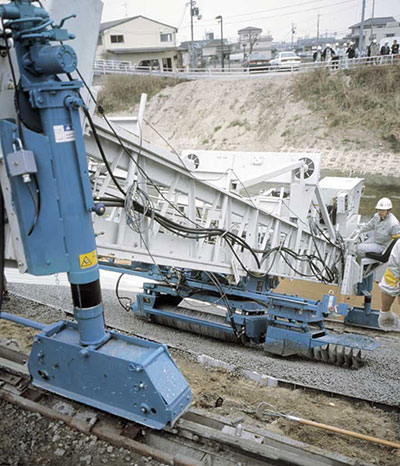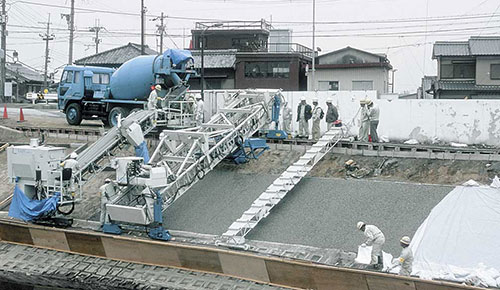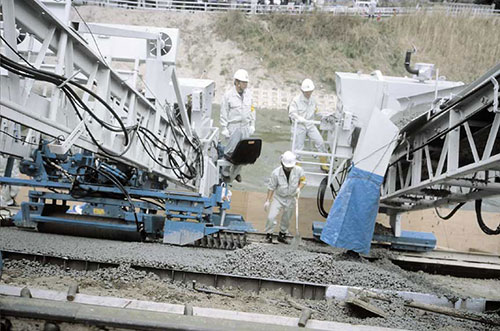GOMACO World Index --- GOMACO World 32.1 - February 2004
A "Green" And Easy Solution For Flood Control Problems
After the slopes are finished, they’re sprayed with a seed mixture that grows in the porous concrete and roots in the soil below.
The River Law is the governing rule which all contractors must follow while working on flood control and water utilization projects in the country of Japan. In 1997, that law was amended to not only include the work on the projects, but also to include the preservation of the environment.
Until just last year, the usual method of making environmentally-friendly flood control slopes involved placing precast concrete panels along the bank of the slope. Native grasses and plants could then grow up through the openings in the precast panels.
The problem was, though, that plants rarely grew in thick enough to cover the panel. It wasn't the aesthetically pleasing look most people were hoping for. The process of laying the panels is also time consuming and expensive for contractors. A different method needed to be developed that was less labor intensive, easier to accomplish and, ultimately, had the finished look that people wanted while preserving the environment in case of flooding.
One Japanese contractor, Sato Road Company Ltd., is taking the lead in building these new, environmentally-friendly "green" flood control projects. They're using their GOMACO RC Conveyor and SL-450 slope finisher as part of the process.
Sato Road developed the perfect solution. They created a new type of concrete mix design with coarse aggregates, cement paste, mortar and a 25 percent air-void content. The no-fines mix could then be placed on any slope with their SL-450 finisher. The new concrete slope would be porous enough to allow plants and grasses to grow root systems into the earth below. In the event of a flood, the plants could hold firm to the soil below and the result would be less erosion and damage due to the flood waters within the canal.
The idea was embraced by officials and the first project was built. Sato Road introduced the "Eco-Based Construction Method" to the country of Japan for the first time on a project reconstructing the bank of the Akishino River in the Nara Prefecture.
The rebuilt river canal is 210 feet (64 m) long, finished at a width of 13 feet (4 m) and had a total work area of 2917 feet2 (271 m2). The canal had a 26.5 degree slope and would have a finished thickness of 7.9 inches (200 mm). The project would take just two days to complete.
Ready-mix trucks hauled the no-fines concrete mix to the job site. They discharged directly into the hopper on Sato Road's RC Conveyor. The RC Conveyor placed the concrete uniformly across the width of the canal.
An SL-450 slope finisher followed behind the conveyor and finished the porous concrete to the required specifications.
"Backhoes, or small compacting machines, are sometimes used to place the concrete on projects," Yoichi Noguchi, technical division manager at Sato Road, said. "Under such methods, however, the rolling pressure cannot be kept constant, thus resulting in variations in quality in the concrete. The cylinder finisher is designed to compact the concrete with rollers, applying a predetermined pressure to the concrete, which assures a uniform concrete placement."
During the first day of production they finished approximately 1830 feet2 (170 m2) of canal. The second day they finished the project by completing the remaining 1076 feet2 (100 m2) of canal. Production averaged between 807 to 1076 feet2 (75 to 100 m2) per hour on both days of the pour.
"If we had placed precast concrete units by manual labor, we would have completed an area of only approximately 538 feet2 (50 m2) per day," Noguchi explained. "The new method can carry out the work at a two to three times faster pace compared to those conventional methods."
Not only is the new method faster than the conventional precast concrete panel method, it is also more economical. Noguchi estimates the average savings per project is approximately 20 percent.
A third advantage of Sato Road's new porous concrete method is that it accomplishes both environmental preservation and flood control for the canal, two major objectives in Japan's River Law.
"There are other various advantages, too," Yoshio Adagawa, chief researcher for Japan's Advanced Construction Technology Center, said. "For example, you can control the kind of plants that will root inside the concrete to give it a natural look. For all of these reasons, I believe the use of porous concrete will continue to increase in the future."
Sato Road also believes in the future of "green" flood control slopes. After completing their first project with the new method, its parent company, Sato Kogyo Company Ltd., has made Sato Road its own independent company. In this sense, the "Eco-Based Construction Method" will serve as a new kind of business for Sato Road. They have even formed a new association to promote their "green" ecologically-friendly paving, called the Eco Base Association.
The SL-450 assures uniform concrete placement and slope thickness and finishes the slopes at a much faster rate than placing preformed concrete panels.
Subscribe to Receive GOMACO World Magazine
